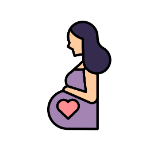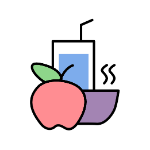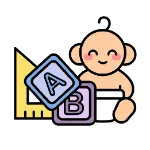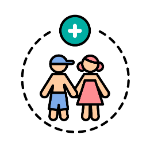
Childcare
Know How To Start Your Kid On Solid Foods
8 min | Updated on 06-02-2022 by HappyPreggie
One of the most wonderful (if messy) milestones of your baby's first year is the introduction of solid foods. Consider the variety of flavors and textures available to your child, from salty cheddar to sweet mango to creamy avocado. Starting solids is the first step toward discovering and exploring a universe of flavors.
Encourage your baby to take joy in tasting new things, even if a large percentage of them end up on her bib, tray, or floor. It's all part of a grand attempt to push those taste senses to new levels.

(Image credits to Canva)
Is it better to eat rice, oatmeal, or barley? What kind of infant cereal or other food will you serve your baby for his or her first solid meal? Have you decided on a date? You may have planned at this stage, or you may be perplexed because you have heard too much conflicting advice from family and friends.
But don’t worry; we are here to help you with full guidance on how to start your kid on solid foods. Just follow this and you’re good to go.
Although most babies are ready to start solids between the ages of 4 and 6 months, your child's individual development is the most important factor to consider when choosing whether or not it's time to move to a more varied diet.

(Image credits to Canva)
Though you may be tempted to get on the feeding bandwagon as soon as possible, there are several reasons why introducing a baby on solids too soon isn't a good idea. To begin with, a very young baby's digestive system is undeveloped for solids, from a tongue that pushes away any foreign object placed on it to intestines that lack numerous digestion enzymes. Plus, solids aren't essential during the first six months of life; breast milk or formula may provide all of a baby's nutritional demands.
Introducing solids too soon might also jeopardize future eating habits (infant may refuse those spoonfuls at first simply because she isn't ready, then later because of parental pressure). Early solid food introduction, especially in formula-fed newborns, can contribute to obesity later in the growing stage and beyond.
Waiting too long — say, till 9 months or later — can, on the other hand, lead to significant complications. An older infant may be resistant to learning the new (and difficult) skills of chewing and swallowing solids, choosing instead to cling to the tried-and-true (and simple) techniques of nursing or bottle-feeding. Tastes, like habits, might be difficult to modify at this point. When milky liquids have long dominated the menu, an older baby, unlike the more malleable younger baby, may not be as amenable to solids.
Look for the following signs to see if your baby is ready to take the major step into the world of solid meals, and then check with your doctor:
i. If your baby can hold his head up:
If your baby can not hold his/her head up do not offer any food to them, even the strained baby foods should be avoided too. You should wait to give your baby chunkier food to a baby until he/she is able to sit alone, which is usually by 7 months of age.
ii. The tongue-thrust reflex is no longer present:
Out from the tip of a baby spoon or your finger, place a small bit of baby-appropriate food diluted with breast milk or formula in your baby's mouth. If the food comes back immediately out with that tiny tongue after multiple attempts, the thrust is still present, and the infant isn't ready to be spoon-fed.
iii. Your infant reaches for table meals and generally expresses an interest in them:
If she's snatching your fork or looking at you closely and joyfully with each bite you take, it's an indication she's ready for something more grown-up.
iv. He opens his mouth when food comes his way:
If your baby watches you eat, reaches for your food, and appears eager to be fed, they may be ready.

(Image credits to Canva)
Practicing healthy food intake is one of the earliest and most important aspects of growing a good eater. Babies who observe grownups eating well and enjoying themselves are more likely to want to emulate them.
Here are a few additional suggestions to assist your infant to learn to eat solid foods:
The "ideal" time to feed your child is whenever is convenient for both of you. When your milk production is at its lowest, you might attempt solids if you're breastfeeding. Experiment: Introduce foods after the first course of formula or breast milk to stimulate the appetite. Start with one meal each day, then gradually increase to two (most likely a morning and evening meal) over the next month or so.

(Image credits to Canva)
Those first feedings are difficult for you, but they're far more difficult for your baby. So keep in mind that a happy, alert baby is more likely to open wide for an incoming spoon, but a fussy or drowsy kid may just desire breast milk (or bottle). Be flexible if your baby is cranky; you may want to forego solids at that meal and try them again later.

(Image credits to Canva)
When it comes to babies, food is never fast – you'd be shocked how long it takes to get one small mouthful into that tiny mouth (and ultimately down the hatch). Allow plenty of time for feedings for both you and your baby, as well as lots of practice. It'll come in handy.

(Image credits to Canva)
Trying to put an unfamiliar item into an unreceptive mouth while carrying a wiggling baby on your lap is a recipe for catastrophe. Allow your baby to practice sitting in the high chair or feeding seat for a few days before giving her a mouthful, adjust the height of the tray or seat until it fits perfectly.
Always tie the safety straps, including the one around the crotch, because your little worm can be restless. If your baby can't sit up in such a chair or seat, it's usually best to hold off on meals for a while.
A silicone, rubber, or corn-based model with a small, soft bowl is significantly nicer on fragile gums than a silver spoon. Keep several spoons on hand when you are feeding, one for you and one for the baby to hold to divert baby’s mind and avoid struggles. While you are getting ready to feed your baby, don’t forget to put a bib on the baby otherwise the food will fall down here and there.

(Image credits to Canva)
Place a little bit of the food on the table or high chair tray and let baby to touch, squish, crush, and possibly taste it before attempting to bring the spoon to mouth. That way, when you do use with the spoon, you won't be offering something completely different.

(Image credits to Canva)
For the new solid eaters, even the blandest tasted food might taste interesting. But you have to keep in mind that babies can reject the food the first time or more than that when you try feeding. So, if your baby refuses to eat from the spoon, don't force it. However, give it another shot on a different day.

(Image credits to Canva)
What your baby monkey sees may influence what she does. It's an oldie but a goodie for parents: Open your mouth wide and take a pretend mouthful from the spoon – don't forget to smack your lips and vigorously enjoy your pretend bite.

(Image credits to Canva)
It's just as crucial to know when to stop feeding as it is to understand when to start. A clenched jaw or a tilted head are obvious signals that the baby has finished his or her food. Forcing a baby to eat is a losing battle that might lead to future food disputes.
Aside from whatever reasonable concerns you might have about wasting food, it's not a reason to panic if most of what you feed your infant end up on the floor or otherwise uneaten. Your baby's first food experiments are more about the "experiment" than the meal - in other words, they're more about acquiring experience than sustenance. Breast milk or formula will continue to provide the majority of your child's nutritional needs for the first year.
It's essential for your child to become familiar with the feeding process, which includes sitting up, eating from a spoon, resting between bites, and stopping when full. These early experiences will aid your child in developing healthy eating habits that will last a lifetime.
From the first feeding, encourage family meals. When you get the opportunity, sit with your entire family. According to research, eating dinner as a family on a regular basis has a good impact on children's development. Remember to provide your child with a wide selection of healthy foods that are high in the nutrients he or she requires.
If you want to read more, you can read- 8 Signs That Show Your Baby Is Healthy or you can also read- 8 Homemade Baby Foods You Get In Malaysia.
Encourage your baby to take joy in tasting new things, even if a large percentage of them end up on her bib, tray, or floor. It's all part of a grand attempt to push those taste senses to new levels.
(Image credits to Canva)
But don’t worry; we are here to help you with full guidance on how to start your kid on solid foods. Just follow this and you’re good to go.
When do babies start eating solid foods?
Although most babies are ready to start solids between the ages of 4 and 6 months, your child's individual development is the most important factor to consider when choosing whether or not it's time to move to a more varied diet.
(Image credits to Canva)
Though you may be tempted to get on the feeding bandwagon as soon as possible, there are several reasons why introducing a baby on solids too soon isn't a good idea. To begin with, a very young baby's digestive system is undeveloped for solids, from a tongue that pushes away any foreign object placed on it to intestines that lack numerous digestion enzymes. Plus, solids aren't essential during the first six months of life; breast milk or formula may provide all of a baby's nutritional demands.
Introducing solids too soon might also jeopardize future eating habits (infant may refuse those spoonfuls at first simply because she isn't ready, then later because of parental pressure). Early solid food introduction, especially in formula-fed newborns, can contribute to obesity later in the growing stage and beyond.
Waiting too long — say, till 9 months or later — can, on the other hand, lead to significant complications. An older infant may be resistant to learning the new (and difficult) skills of chewing and swallowing solids, choosing instead to cling to the tried-and-true (and simple) techniques of nursing or bottle-feeding. Tastes, like habits, might be difficult to modify at this point. When milky liquids have long dominated the menu, an older baby, unlike the more malleable younger baby, may not be as amenable to solids.
What are the signs that the baby is ready for solid food?
Look for the following signs to see if your baby is ready to take the major step into the world of solid meals, and then check with your doctor:
i. If your baby can hold his head up:
If your baby can not hold his/her head up do not offer any food to them, even the strained baby foods should be avoided too. You should wait to give your baby chunkier food to a baby until he/she is able to sit alone, which is usually by 7 months of age.
ii. The tongue-thrust reflex is no longer present:
Out from the tip of a baby spoon or your finger, place a small bit of baby-appropriate food diluted with breast milk or formula in your baby's mouth. If the food comes back immediately out with that tiny tongue after multiple attempts, the thrust is still present, and the infant isn't ready to be spoon-fed.
iii. Your infant reaches for table meals and generally expresses an interest in them:
If she's snatching your fork or looking at you closely and joyfully with each bite you take, it's an indication she's ready for something more grown-up.
iv. He opens his mouth when food comes his way:
If your baby watches you eat, reaches for your food, and appears eager to be fed, they may be ready.
What is the best way to introduce solid foods to your baby?
(Image credits to Canva)
Practicing healthy food intake is one of the earliest and most important aspects of growing a good eater. Babies who observe grownups eating well and enjoying themselves are more likely to want to emulate them.
Here are a few additional suggestions to assist your infant to learn to eat solid foods:
#1 Find the right time
The "ideal" time to feed your child is whenever is convenient for both of you. When your milk production is at its lowest, you might attempt solids if you're breastfeeding. Experiment: Introduce foods after the first course of formula or breast milk to stimulate the appetite. Start with one meal each day, then gradually increase to two (most likely a morning and evening meal) over the next month or so.
(Image credits to Canva)
#2 Check on baby’s mood
Those first feedings are difficult for you, but they're far more difficult for your baby. So keep in mind that a happy, alert baby is more likely to open wide for an incoming spoon, but a fussy or drowsy kid may just desire breast milk (or bottle). Be flexible if your baby is cranky; you may want to forego solids at that meal and try them again later.
(Image credits to Canva)
#3 Do not rush
When it comes to babies, food is never fast – you'd be shocked how long it takes to get one small mouthful into that tiny mouth (and ultimately down the hatch). Allow plenty of time for feedings for both you and your baby, as well as lots of practice. It'll come in handy.
(Image credits to Canva)
#4 Put her in the right position
Trying to put an unfamiliar item into an unreceptive mouth while carrying a wiggling baby on your lap is a recipe for catastrophe. Allow your baby to practice sitting in the high chair or feeding seat for a few days before giving her a mouthful, adjust the height of the tray or seat until it fits perfectly.
Always tie the safety straps, including the one around the crotch, because your little worm can be restless. If your baby can't sit up in such a chair or seat, it's usually best to hold off on meals for a while.
#5 Gear up
A silicone, rubber, or corn-based model with a small, soft bowl is significantly nicer on fragile gums than a silver spoon. Keep several spoons on hand when you are feeding, one for you and one for the baby to hold to divert baby’s mind and avoid struggles. While you are getting ready to feed your baby, don’t forget to put a bib on the baby otherwise the food will fall down here and there.
(Image credits to Canva)
#6 Make her familiar
Place a little bit of the food on the table or high chair tray and let baby to touch, squish, crush, and possibly taste it before attempting to bring the spoon to mouth. That way, when you do use with the spoon, you won't be offering something completely different.
(Image credits to Canva)
#7 Expect the rejection
For the new solid eaters, even the blandest tasted food might taste interesting. But you have to keep in mind that babies can reject the food the first time or more than that when you try feeding. So, if your baby refuses to eat from the spoon, don't force it. However, give it another shot on a different day.
(Image credits to Canva)
#8 Invite imitation
What your baby monkey sees may influence what she does. It's an oldie but a goodie for parents: Open your mouth wide and take a pretend mouthful from the spoon – don't forget to smack your lips and vigorously enjoy your pretend bite.
(Image credits to Canva)
#9 Know when it’s enough
It's just as crucial to know when to stop feeding as it is to understand when to start. A clenched jaw or a tilted head are obvious signals that the baby has finished his or her food. Forcing a baby to eat is a losing battle that might lead to future food disputes.
#10 Don’t worry about the portion
Aside from whatever reasonable concerns you might have about wasting food, it's not a reason to panic if most of what you feed your infant end up on the floor or otherwise uneaten. Your baby's first food experiments are more about the "experiment" than the meal - in other words, they're more about acquiring experience than sustenance. Breast milk or formula will continue to provide the majority of your child's nutritional needs for the first year.
It's essential for your child to become familiar with the feeding process, which includes sitting up, eating from a spoon, resting between bites, and stopping when full. These early experiences will aid your child in developing healthy eating habits that will last a lifetime.
From the first feeding, encourage family meals. When you get the opportunity, sit with your entire family. According to research, eating dinner as a family on a regular basis has a good impact on children's development. Remember to provide your child with a wide selection of healthy foods that are high in the nutrients he or she requires.
If you want to read more, you can read- 8 Signs That Show Your Baby Is Healthy or you can also read- 8 Homemade Baby Foods You Get In Malaysia.
Join the largest support network for family health and well-being. Ready to get started?
Get started
















